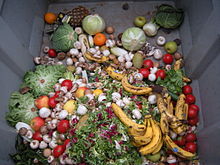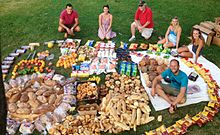
Back إهدار الطعام Arabic খাদ্য অপচয় Bengali/Bangla Residu alimentari Catalan Plýtvání potravinami Czech Madaffald Danish Lebensmittelverschwendung German Manĝorubo Esperanto Desperdicio alimenticio Spanish Toidujäätmed Estonian پسماند غذایی Persian

| Part of a series on |
| Pollution |
|---|
 |

Food loss and waste is food that is not eaten. The causes of food waste or loss are numerous and occur throughout the food system, during production, processing, distribution, retail and food service sales, and consumption. Overall, about one-third of the world's food is thrown away.[2][3] A similar amount is lost on top of that by feeding human-edible food to farm animals (the net effect wastes an estimated 1144 kcal/person/day). A 2021 meta-analysis, that did not include food lost during production, by the United Nations Environment Programme found that food waste was a challenge in all countries at all levels of economic development.[4] The analysis estimated that global food waste was 931 million tonnes of food waste (about 121 kg per capita) across three sectors: 61 percent from households, 26 percent from food service and 13 percent from retail.[4]
Food loss and waste is a major part of the impact of agriculture on climate change (it amounts to 3.3 billion tons of CO2e emissions annually[5][6]) and other environmental issues, such as land use, water use and loss of biodiversity. Prevention of food waste is the highest priority, and when prevention is not possible, the food waste hierarchy ranks the food waste treatment options from preferred to least preferred based on their negative environmental impacts.[7] Reuse pathways of surplus food intended for human consumption, such as food donation, is the next best strategy after prevention, followed by animal feed, recycling of nutrients and energy followed by the least preferred option, landfill, which is a major source of the greenhouse gas methane.[8] Other considerations include unreclaimed phosphorus in food waste leading to further phosphate mining. Moreover, reducing food waste in all parts of the food system is an important part of reducing the environmental impact of agriculture, by reducing the total amount of water, land, and other resources used.
The UN's Sustainable Development Goal Target 12.3 seeks to "halve global per capita food waste at the retail and consumer levels and reduce food losses along production and supply chains, including post-harvest losses" by 2030.[9] Climate change mitigation strategies prominently feature reducing food waste.[10][failed verification] In the 2022 United Nations Biodiversity Conference nations agree to reduce food waste by 50% by the year 2030.[11]
- ^ Greenfield, Robin (October 6, 2014). "The Food Waste Fiasco: You Have to See it to Believe it!". www.robingreenfield.org.
- ^ Jenny Gustavsson. Global food losses and food waste : extent, causes and prevention : study conducted for the International Congress "Save Food!" at Interpack 2011 Düsseldorf, Germany. OCLC 1126211917.
- ^ "UN Calls for Action to End Food Waste Culture". Daily News Brief. October 4, 2021. Archived from the original on 2021-10-04. Retrieved 2021-10-04.
- ^ a b UNEP Food Waste Index Report 2021 (Report). United Nations Environment Programme. March 4, 2021. ISBN 9789280738513. Archived from the original on 2022-02-01. Retrieved 2022-02-01.
- ^ "FAO - News Article: Food wastage: Key facts and figures". www.fao.org. Archived from the original on 2021-06-07. Retrieved 2021-06-07.
- ^ "A third of food is wasted, making it third-biggest carbon emitter, U.N. says". Reuters. September 11, 2013. Archived from the original on 2021-06-07. Retrieved 2021-06-07.
- ^ "Brief on food waste in the European Union". European Commission. August 25, 2020. Archived from the original on 2022-11-15. Retrieved 2022-11-15.
- ^ "Food Recovery Hierarchy". www.epa.gov. August 12, 2015. Archived from the original on 2019-05-23. Retrieved 2022-05-15.
- ^ United Nations (2017) Resolution adopted by the General Assembly on 6 July 2017, Work of the Statistical Commission pertaining to the 2030 Agenda for Sustainable Development (A/RES/71/313 Archived 2020-10-23 at the Wayback Machine)
- ^ "Reduced Food Waste". Project Drawdown. February 12, 2020. Archived from the original on 2020-09-24. Retrieved 2020-09-19.
- ^ Cite error: The named reference
CBDwas invoked but never defined (see the help page).